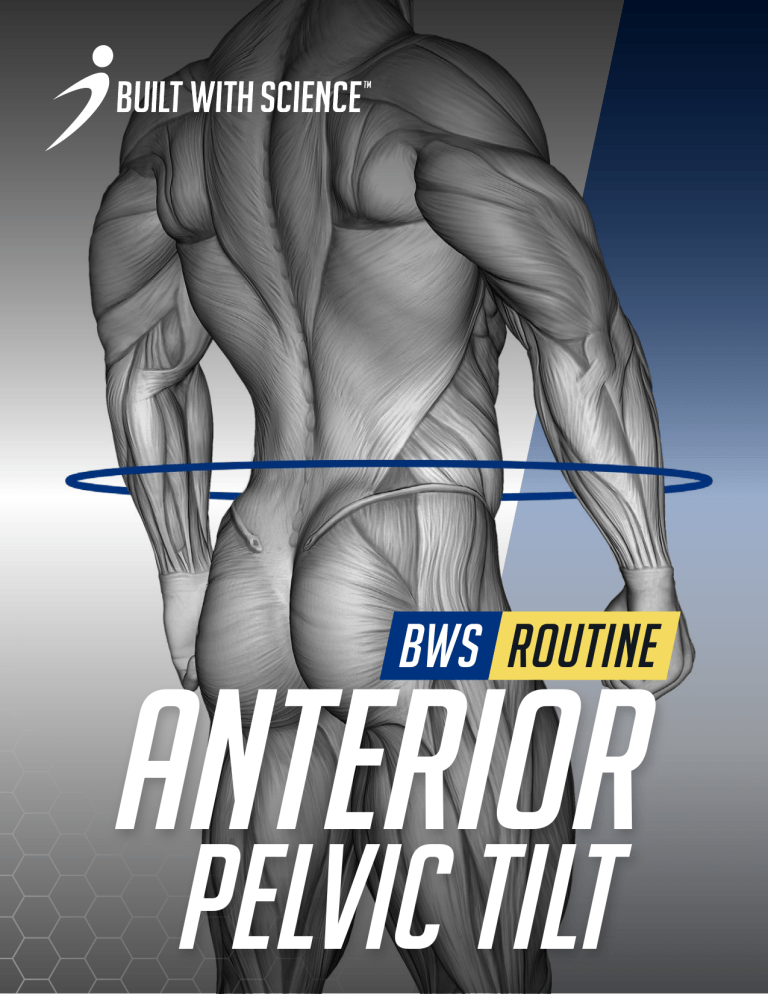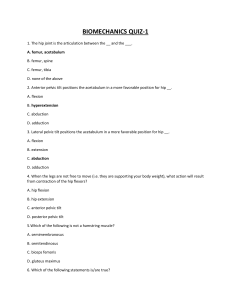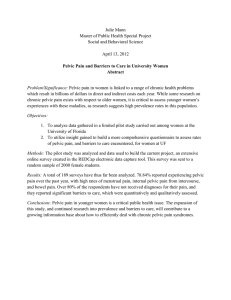
bws routine anterior pelvic tilt anterior pelvic tilt routine Table of contents DAILY CORRECTIVE ROUTINE Exercise 1: Lying Pelvic Tilts Exercise 2: Standing Pelvic Tilts Exercise 3: Bodyweight Hip Thrusts Shortcut Your Transformation! Exercise 4: RKC Plank Exercise 5: Lunge Stretch Exercise 6: Rectus Femoris Stretch EXERCISE PROGRESSIONS LONG-TERM PLAN ADDITIONAL COMMENTS DISCLAIMER @jeremyethier 3 4 5 6 7 8 9 10 11 12 13 14 2 anterior pelvic tilt routine DAILY CORRECTIVE ROUTINE Exercise Sets Reps REST Lying Pelvic Tilts 1 10 30 seconds Standing Pelvic Tilts 1 10 30 seconds Bodyweight Hip Thrusts 3 10+ 1 minute RKC Plank 2 - 1 minute Lunge Stretch 2 Keep for 30 seconds - Rectus Femoris Stretch 2 Keep for 30 seconds @jeremyethier 3 anterior pelvic tilt routine Exercise 1: Lying Pelvic Tilts STEP 1 STEP 1 Lay with your back on the ground, knees bent, and feet flat on the floor about shoulder-width apart. You should notice a gap between your lower back and the floor. STEP 2 Flatten this gap by pushing your lower back into the floor by contracting your abdominals and squeezing your glutes. What you just did is called “posterior pelvic tilt”. Repeat this by going back and forth between an arched lower back and a flattened lower back. The goal with this exercise is to familiarize yourself with what a posterior pelvic tilt feels like. @jeremyethier STEP 2 4 anterior pelvic tilt routine Exercise 2: Standing Pelvic Tilts STEP 1 Perform the same protocol as the lying pelvic tilts, but this time standing up. Focus on squeezing the glutes and contracting the abs as you move from anterior pelvic tilt into posterior pelvic tilt. STEP 1 STEP 2 Stand relaxed with your feet shoulder-width apart. STEP 2 Then, squeeze the glutes to come into posterior pelvic tilt. @jeremyethier 5 anterior pelvic tilt routine Exercise 3: Bodyweight Hip Thrusts Basically, all you’re doing is driving your hips up towards the ceiling. But there are a few key important points you need to keep in mind. 1. Keep your shoulder blades on the bench and place your feet so that your shins are vertical at the top position of the thrust. 2. Don’t arch your lower back as you perform the movement. 3. Instead, posteriorly tilt your pelvis by actively squeezing the glutes. 4. At the top position, you should be able to draw a straight line from your upper body to your knees. @jeremyethier 6 anterior pelvic tilt routine Shortcut Your Transformation! LOOKING FOR MORE SCIENCE-DRIVEN WORKOUTS TO ADD TO YOUR ROUTINE? ACCESS MORE SCIENCE-BASED WORKOUTS AND NUTRITION PLAN TO LOSE FAT AND BUILD MUSCLE IN THE MOST EFFECTIVE WAY POSSIBLE. That’s exactly what my #BuiltWithScience programs are designed to do. We show you step by step with our software how much your specific body should be eating to see the best results, and then pair this with an optimized workout plan designed for you to pack on lean muscle as fast as possible (and without the fat!). It’s how thousands of our members like Anthony are seeing amazing results and breaking through plateaus in such a short amount of time. To join the family and get started today, click the button below to discover which of our programs would be best suited for you and where your body is currently at. CLICK HERE TO DISCOVER THE BEST PROGRAM FOR YOU! @jeremyethier 7 anterior pelvic tilt routine Exercise 4: RKC Plank Here’s some key points for proper execution of this exercise: 1. Set up how you would in a standard plank but with your hands interlocked and your feet slightly wider than normal. 2. Activate your abdominals by thinking about drawing your belly button towards your spine. 3. Using what you learned in exercise 1, posteriorly pelvic tilt your hips by squeezing your glutes and keeping them contracted as you hold the plank. 4. Hold this position for as long as possible without letting your lower back arch. 5. You should feel a strong contraction in your glutes and abdominals, as shown below. @jeremyethier 8 anterior pelvic tilt routine Exercise 5: Lunge Stretch STEP 1 Get into a lunge position with both knees at 90 degrees. Contract your abdominals by thinking about drawing your belly button towards your spine AND move your hips into posterior pelvic tilt. The goal is to feel a deep stretch in the front of your back leg. Many of you will find that this position (step 1 in the photo) already provides an adequate stretch. STEP 2 For a deeper stretch, simply lean forward while maintaining your posterior pelvic tilt as you shift forward (step 2 in the photo). STEP 3 For an even deeper stretch, rotate your upper body to the opposite side (step 3 in the photo). Hold each side for around 10 deep breaths. @jeremyethier 9 anterior pelvic tilt routine Exercise 6: Rectus Femoris Stretch OPTION 1 Place your back foot up on a bench or couch with your other foot planted forward. Again, you want to contract your abdominals by drawing your belly button towards your spine AND move your hips into posterior pelvic tilt. You should feel a deep stretch down the front of your thigh. OPTION 2 You can move forward slightly for less of a stretch or move closer to the bench for more of a stretch. Another option is to do these without a bench by pulling up the back leg. @jeremyethier 10 anterior pelvic tilt routine EXERCISE PROGRESSIONS The lying/standing pelvic tilts and hip flexor stretches should be a staple in your corrective routine. These exercises and stretches don’t necessarily need to be progressed (although you could increase the frequency in which you do them overtime). However, with that being said, there are progressions for the hip thrust and the RKC plank which you should utilize. 1. BODYWEIGHT HIP THRUST PROGRESSION The easiest way to progress this exercise is by simply adding weight to the movement. You can do this by performing barbell (or any weighted bar) hip thrusts. My advice is that once you can perform multiple sets of 20+ reps of bodyweight hip thrusts with good form (posterior pelvic tilt), then you should be ready to try it out with a barbell and start adding weight to it. However, these weighted hip thrusts should then be integrated into your leg workouts as opposed to performing them daily. The added load will require more recovery time for your glutes. Another viable option is to perform elevated single-leg hip thrusts as seen below. You want to use the same tips as in the bodyweight hip thrusts. These can be done every other day or integrated into your leg workouts. 2. RKC PLANK PROGRESSIONS The easiest way to progress this exercise is by simply holding the position for a longer period of time as you get stronger. However, ideally you want to start adding in other abdominal exercises as you get better at minimizing the involvement of your hip flexors. Some potential options are: • • • • Lying leg raises (with a posterior pelvic tilt) Decline leg raises (with a posterior pelvic tilt) Ab wheel rollout Hollow body holds You can incorporate these additional ab exercises into an ab workout on its own, which can be done 2-3 times per week as opposed to daily. But this should only be considered after your anterior pelvic tilt is noticeably better from performing the original daily corrective routine. @jeremyethier 11 anterior pelvic tilt routine LONG-TERM PLAN Use the following guidelines for the best long-term strategy for correcting anterior pelvic tilt and making sure it stays that way! 1. Consistently use the daily corrective routine I provided for a couple months. You should notice a big difference in your pelvic tilt position. 2. You can then start to experiment with exercise progressions such as the weighted hip thrusts and abdominal progression exercises I mentioned. I would still stretch the hip flexors and perform the standing/lying pelvic tilts daily, but the weighted hip thrusts can be integrated into your leg workouts and the abdominal exercises can be done on their own 2-3 times per week. 3. Be aware of how your posture is throughout the day. Take frequent walk breaks if you sit for extended periods throughout the day, and watch your pelvic position when performing squats and deadlifts! @jeremyethier 12 anterior pelvic tilt routine ADDITIONAL COMMENTS I hope this PDF is useful for you! I put in a lot of effort into providing this routine for you free of charge. All I ask in return is that you show your support for my work and connecting with me on my social media platforms where I share more informative content on a regular basis: website BUILTWITHSCIENCE.COM instagram @JEREMYETHIER youtube youtube.com/jeremyethier tiktok tiktok.com/@jeremyethier facebook @JEREMYETHIERfit ENJOY! @jeremyethier 13 anterior pelvic tilt routine DISCLAIMER The content provided in this PDF is for informational and educational purposes only. Jeremy Ethier is not a medical doctor, psychologist, therapist, nutritionist, or registered dietitian. The contents of this document should not be construed as medical, psychological, dietary, nutritional, or healthcare advice of any kind. The contents of this document are not intended to diagnose, treat, cure, or prevent any health conditions, nor are they intended to replace a physician, dietitian, nutritionist, or other qualified healthcare professional’s advice. You should always consult your physician, dietitian, or other qualified healthcare professional on any matters regarding your health, engagement in physical activity, and/or diet before starting any fitness program or meal plan to determine if it is suitable for your needs. This is especially important if you (or your family members) have a history of high blood pressure or heart disease, if you have ever experienced chest pain while exercising, or if you have experienced chest pain in the past month when not engaged in physical activity. You should also consult your physician, dietitian, or other qualified healthcare professional before starting any fitness program, meal plan, or dietary regimen if you smoke, have high cholesterol, are obese, or have a bone or joint problem that could be made worse by a change in physical activity or diet. Do not start or continue any fitness program, meal plan, or dietary regimen if your physician, dietitian, or health care provider advises against it. If you experience faintness, dizziness, pain, shortness of breath or any other form of discomfort at any time while exercising or while following any meal plan/dietary regimen, you should stop immediately. If you are in Canada and think you are having a medical or health emergency, call your health care provider, or 911, immediately. @jeremyethier Please note the following: • any and all exercise that you do as a result of what you read in this PDF shall be performed solely at your own risk; • any and all meal plans that you follow or adhere to as a result of what you read in this PDF shall be used solely at your own risk; and • any and all foods or beverages that you consume as a result of what you read in this PDF shall be consumed solely at your own risk. No part of this report may be reproduced or transmitted in any form whatsoever, electronic or mechanical, including photocopying, recording, or by any informational storage or retrieval system without the express written, dated, and signed permission from the author (Jeremy Ethier). All copyrights are reserved. Built With Science™ may not be copied or used for any purpose without express written consent. 14 anterior pelvic tilt routine

